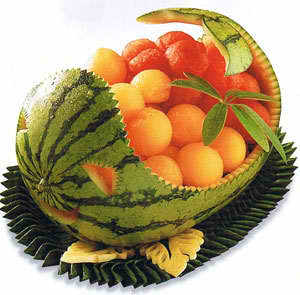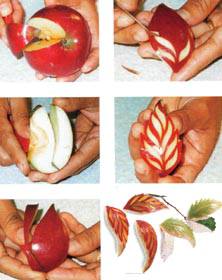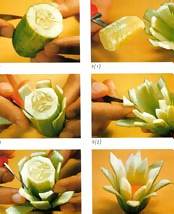
The purpose of fruit and vegetable carving is to make food more attractive,
more appetizing, and also easier to eat. The accomplished homemaker welcomes her
guests with fruit carefully pared, seeded, and perhaps cut into bite-size slices
depending on the type. Vegetables are first delicately carved, then cooked, and
finally arranged attractively to decorate the dish which they are part of.
Needless to say, guests are greatly pleased to be honored with such a gracious
welcome, displaying as it does the good feelings and willing hospitality of the
maker.
Decorating fresh, well-formed, and colorful fruits and vegetables through
artistic carving is by no means difficult; all it takes is concentration.
Starting out, there is no need for special carving knives; one sharp-pointed
knife is enough to carve fruits and vegetables beautifully. The knife, however,
must be sharp at all times, and so you should always have a small whetstone
nearb.

1. Before carving, fruits and vegetables must be washed and cleaned
thoroughly.
2. Use knives with stainless steel or bronze blades. Knives with
ordinary steel blades will cause discoloration of fruits and vegetables.
3.
Do not carve excessively so as to avoid waste and loss of nutritional
value.
4. The designs carved should be appropriate for decorating a plate of
food; thus, floral patterns are suitable, while figures of animals such as rats
are not.
5. Vegetables to be dipped into sauces should be cut to appropriate
sizes.
6. Vegetables chosen for carving should be appropriate to the dish in
which they are to be used, and they should be vegetables which are resistant to
wilting, such as carrots and Chinese radishes.
7. Care must be exercised
during carving so as to avoid bruising fruit and vegetables.
Each kind of fruit and vegetable has its own unique characteristics, so keep
these pointers in mind when choosing fruits and vegetables to carve.
whitelotus
1. Onions and shallots should be fresh and without wrinkles. Choose either
mediumsized or small bulbs that are all of uniform size.
2. Carrots should be
straight and of medium or large-size.
3Radishes should be fresh, firm, and
round. Use medium-sized radishes, all of uniform size.
4. Chinese radishes
should be straight and of medium-size with clear bright skins. The flesh of
large Chinese radishes tends to be mealy.
5.Cucumbers should be green,
straight, and of medium-size. The type called for in this book is the larger
type (Tang Ran). If the smaller type (Tang Kwa) is used, those with green skins
have firmer flesh and are better for carving than those with greenish white
skins.
6.Tomatoes should be of uniform size. Plum tomatoes, with elongated
fruits, are firmer than round varieties. Choose fresh ones with no
wrinkles.
7.Pumpkins should have thick, firm flesh.Such pumpkins have a rough
exterior.
8.Spur chillies should be fresh and have firm skins. Generally
small ones are used, because if large ones were cut and spread out to make a
blossom, they would cover the entire plate. However, large spur chilies are used
for making anthurium flowers.
9.Spring shallots and leek should be fresh and
green with no yellowing on the leaves. Select thick, medium-sized
plants.
10.Cabbage and Chinese cabbage should be fresh with firm, heavy
heads. Use medium sized heads.
11.Lemons should be very fresh.
12.Taro
should be of medium-size. The fragrant taro (Pheuak Hawm) has fine-textured
flesh.
13.Cantaloupes should be those that are not yet fully ripe. The skin
should be pale yellow without wrinkles or scratches.
14.Yam bean tubers used
for carving should not be too large. Large, mature tubers have a lot of fibers.
These become frayed in carving, detracting from the appearance of the finished
work.
15.Papayas should be straight, thick-fleshed and without any bruises.
They should not yet be fully ripe so that the flesh is firm and does not bruise
easily. The Khaek Dam variety is recommended be cause of thebeautifully colored
flesh.
16.Green mangoes should be fully mature and of a variety whose flesh
is not too crisp. The skin should be green and un-wrinkled and the stem should
look fresh.
17.Watermelon should have red flesh and green rinds with no
bruises or wrinkles.
18.Pineapple should have large eyes. The leaves should be
fresh and green and there should be no shrivelling of the skin or
stem.
19.Guavas should be those that are just becoming ripe. The skin should
be a fresh light green skins and there should be no bruises or
scratches.
20.Apples should be fresh with glossy, brightly colored skins and
no bruises.
Jujubes should have straight fruits with green skins and no
bruises.
Sapodillas must be firm, so avoid fully ripe fruits. The skins
should be even and clear. Avoid sapodillas that have been dyed for the market.
Their skins have a dusty appearance.
< Rose-apples should have clear,
fresh looking skins.
1. Tomatoes should be
soaked in a mixture of lime juice and water to prevent browning.
2. Shallots
and onions should be soaked in water before being peeled and carved to reduce
irritation of the eyes.
3. Taro should be washed thoroughly before being
peeled. If washed after peeling, a slime is released which causes itching.
4.
Carrots should not be soaked in water before carving as this will make the flesh
tougher and more difficult to carve.
5. Beets should be washed in water to
which a little salt has been added. This will reduce loss of color. Also, if
left standing, beets will blacken, so they should be kept moist by spraying them
with water regularly.
6. Potatoes should be washed with water after peeling
to remove the sap and then washed again after carving. This will help prevent
browning.
7. Apples should be soaked in mixture of lime juice and water
before being peeled to prevent browning.
8. Cantaloupes should be washed
before carving. While carving, avoid letting water come into contact with the
fruit because it will lose its taste and spoil more quickly.
9. Yam bean
tubers should be soaked too long after carving, will yellow.
1. After carving, fruits
and vegetables should be placed in ice cold water so the petals of flower
designs are firm and spread beautifully.
2. Carved fruits and vegetables
should not be left in water as this will cause petals to become discolored and
to spoil.
3. Each type of carved fruit should be kept separately. This will
prevent loss of all your work in the event that one type spoils.
4. Store
carved fruits and vegetables by putting them in containers and placing in a
refrigerator, or if no refrigerator is available, by covering them with a damp
piece of thin white cloth and putting them in a place protected from drafts so
they do not dry and wilt.
5. After carving, pumpkin should be dipped in water
and removed right away. If left in water, flower petal designs will become
bruised.
Watermelon Basket Carving Perfect for a summer picnic, this
Watermelon Fruit Basket is carved from a watermelon into the shape of a dolphin.
Kids will love to help draw the pattern on the watermelon rind and make the
melon balls with the help of a melon scoop. Refrigerate until serving time, when
you can sit back and enjoy the compliments.
Materials
One small watermelon Sharp-pointed knife Carving knife Melon scoop
Choose an elongated watermelon. Lightly draw a
dolphin on the rind of the watermelon as in the picture with a sharp point. Cut
along the lines carefully with the knife and then gently cut away the rind. With
a melon scoop, make the flesh into watermelon balls and set aside in a dish.
Remove any remaining flesh so the interior is clean and white.
Cut
triangles through the rind to represent the eyes, and in the edges, cut notches
for the eyelashes. Cut a crescent for the mouth, and then notch the upper border
of the rind all around except at the tail. Arrange the watermelon and cantalope
balls attractively in the dolphin-shaped bowl.
Apple Leaf Material: 2 red
or green apples Equipment: sharp pointed knife, carving knife
1. Wash the apples.
2. Cut a wedged-shape slice as in the picture.
3.
Trim away any of the core, leaving the flesh and skin.
4. With the carving
knife, cut the slice to the shape of a leaf.
5. With the tip of the knife,
make curving grooves in the skin to represent the veins of the leaf. Work from
the base of the leaf to the tip.
6. Cut notches along the edges of the
leaf.
Material: 1 long cucumber
and 1 carrot Equipment: sharp pointed knife and carving knife

1. Wash the cucumbers. Cut into 3
sections.
2. Divide the circumference of each into 8 equal parts and then
make cuts about 3mm deep between each part down the length of the section.
3.
Slice beneath each part down the length almost to the base to separate it from
the flesh, thus forming the 8 outer petals.
4. Trim the flesh to remove
ridges and then divide into 8 parts as before to make the inner ring of petals.
These should be centered between those of the outer ring.
5. Remove the core
of the cucumber, trim each petal so it tapers to a point, and then insert the
center of the flower.
6. For the center, use 1/4" thick disk cut from a small
carrot. Cut small grooves in a crisscross pattern on one face, and place up in
the lotus flower.
You can purchase the book Complete Step by Step
Vegetable and Fruit Carving Fruit & Vegetable Carving Pumpkins Aren't The
Only Artful Fruit Watermelons, turnips, pineapples and many other fruits and
vegetables can be carved and combined into either elegantly simple or very
elaborate center pieces or accents for your picnic table or indoor party
decorations. How to make a watermelon basket How to make a watermelon baby
carriage.
The art of carving foods is an Eastern custom that has been adopted by
creative food preparers around the world. In Thailand and Japan food carving is
considered part of the presentation of the meal. The stunning designs that can
be created makes the food the center of attention when you serve your guests. No
need to worry about what else is on the table! Some of the more elaborate
carvings can take hours to get just right, but practice makes it go faster and
soon you'll find yourself designing your own patterns for watermelons, radishes,
and any fruit or vegetable that can hold it's form when carved. If you've never
seen carved fruits or veggies and you're thinking typical Halloween pumpkin
carving - check out some of these resources and be amazed: These are simple
carved watermelon fruit.
Thank you for visiting my page at Angelfire.
Please come back and visit again!


